The last PQ of this century offered a forum to the forty-seven countries participating in the exhibition of stage and costume design and the exhibition of theatre architecture, as well as those taking part in the presentation of the various schools.
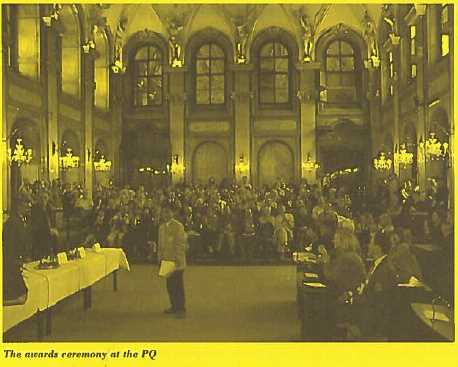 A new division, the thematic of ‘Hommage’ division, was actually dedicated to individual stage and costume designers, although some countries also used the space available to them to present recent artistic developments.
A new division, the thematic of ‘Hommage’ division, was actually dedicated to individual stage and costume designers, although some countries also used the space available to them to present recent artistic developments.
Considering the great diversity of exhibits, it was not easy for the jury to pick the winners. The theatre scholar Arnold Aronson, former chair of the OISTAT Commission for Theory and History, was appointed head of the jury, which consisted this time of ten persons. UNESCO was also awarding prizes to young artists, so a common jury was formed to choose all the prize winners. According to Arnold Aronson, the PQ displayed a “general level of excellence, among the highest seen in recent PQ’s”. There was little, however, that was so outstanding as to be the obvious winner. Apart from a few notable exceptions, the tendency this time was toward “democratic” presentations – exhibits that displayed the work of many designers, but presented only one or two examples of each person’s work. This gave us a good idea of the range of design in a particular country, but made it difficult tot judges the quality of the work of individuals, and this was reflected in the awarding of prizes.
The architecture exhibits also presented outstanding projects. The jury tended to favour designs of interesting spaces for performance – in particular projects that devised innovative solutions for specific problems (an unusual space, complicated renovations, the conversion of non-theatrical space). A major concern was the creation of a warm and hospitable environment for both spectators and performers.
The thematic division was difficult to judge, because the exhibitions were so wide-ranging and therefore difficult tot compare. They included retrospectives of individual artists, the work of young scenographers and costume designers (as well as work by their older, established colleagues), and overviews of both contemporary and historical work.
The exhibition presented by the schools displayed a wide range of teaching methods and artistic concepts that occupied a more prominent place than the presentation of quality handiwork, which was not included in the competition.
The Prizes
In the architecture division three Diplomas of Honour were awarded: one to the Jewish State Theatre in Moscow, another for the competition to design the National Theatre in Budapest, and the third for the conversion of historic places into dynamic theatres in Slovakia. Poland received a silver medal for its creative planning with regard to unusual spaces. The gold medal for architecture was awarded to Brazil in recognition of the varied theatre buildings presented, which were functional and also built to human scale. A special gold medal was awarded to the new Glyndebourne Opera House.
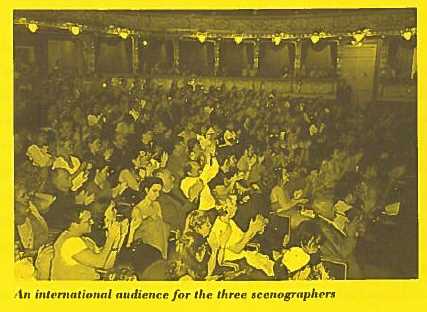 Costume design: A Diploma of Honour was awarded to Rekefet Levy of Israel for “Beheading” and for the Bat Sheva Programme, and another to Elbieta Terlikoska of Poland for “The Old Woman Broods”.
Costume design: A Diploma of Honour was awarded to Rekefet Levy of Israel for “Beheading” and for the Bat Sheva Programme, and another to Elbieta Terlikoska of Poland for “The Old Woman Broods”.
Gold medals were awarded to two works that are very different in nature: to Joan Guillen of Spain/Catalonia for her imaginative design of human and animal forms, and to Jana Prekova of the Czech Republic for her study of the relation between material, the performer, and psychological insight.
Set design: Diplomas of Honour were awarded to Jon Berrondo of Spain/Catalonia, Paul Brown, and Stefanos Lazarides. A gold medal was awarded to the company Fura dels Baus of Catalonia for its creativity in the integration of all elements of stage set.
Thematic division: Korea received the silver medal for the work of Byung-Bok Lee, for her humorous and harmonious costume creations. Germany received the gold medal for its retrospective of the work of Achim Freyer, one of the most important scenographers of the second half of the twentieth century.
The Golden Triga, the highest award of the PQ 99, was given to the best national exhibition. The Czech Republic received this award, for bringing the visitors to its exhibition into close contact with the objectives, the work, and the artistic – and provocative – ambitions of its theatre people.
The jury awarded the UNESCO prize to two young artist for their original work: Vladimir Anson of Estonia and Liz Ascorft of Great Britain. The New Zealand artist were awarded the prize for the best national exhibition. Tribute was paid to the work of the new generation at the schools exhibition: the Woyzeck study undertaken by students from the Netherlands, the varied yet coherent exhibition presented by Great Britain, the philosophical view of the ‘Hamlet’ spatial project undertaken by Tel Aviv University in Israel, and the original project presented by the National University of Arts, Korea.
The OISTAT Architecture Competition
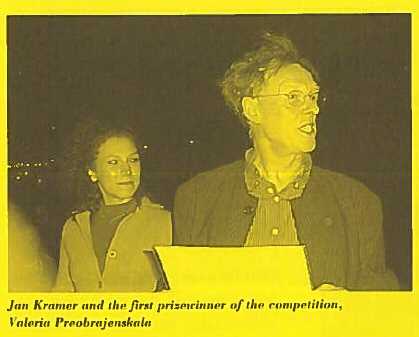 The prize-winning designs of the competition were exhibited in the main hall of the PQ. Two hundred sixteen architects – most of them young – participated in an international competition to come up with ideas for a World Theatre in Prague. The jury included Luc Dhooge (Belgium), Albert Filoni (USA), Sergei Gnedowsky (Russia), Toshiya Kusaka (Japan), and Jan Zavarsky (Slovakia). They were surprised by the encouragingly high number of young woman who participated and won prizes. Young female students from Russia received five of the nine prizes. In addition to their great variety, the originality and functionality of their designs was striking. The prizes were handed out – at an unconventional ceremony held during a tour on the Vltava – by the chair of the OISTAT Architecture Commission, Jan Kramer. The official nomination took place at the general awards ceremony of the PQ at Valdstein Palace. As these young people said themselves, the competition provided them with an important stimulus to their studies, making it possible for them to tackle the problems inherent in the sesign of theatre buildings. The work they submitted to the competition was actually a test of their aptitude for the profession.
The prize-winning designs of the competition were exhibited in the main hall of the PQ. Two hundred sixteen architects – most of them young – participated in an international competition to come up with ideas for a World Theatre in Prague. The jury included Luc Dhooge (Belgium), Albert Filoni (USA), Sergei Gnedowsky (Russia), Toshiya Kusaka (Japan), and Jan Zavarsky (Slovakia). They were surprised by the encouragingly high number of young woman who participated and won prizes. Young female students from Russia received five of the nine prizes. In addition to their great variety, the originality and functionality of their designs was striking. The prizes were handed out – at an unconventional ceremony held during a tour on the Vltava – by the chair of the OISTAT Architecture Commission, Jan Kramer. The official nomination took place at the general awards ceremony of the PQ at Valdstein Palace. As these young people said themselves, the competition provided them with an important stimulus to their studies, making it possible for them to tackle the problems inherent in the sesign of theatre buildings. The work they submitted to the competition was actually a test of their aptitude for the profession.
The jury established the following criteria for judging their work: 1) the possibilities it presented for creating new performance space; 2) whether or not it was an urbane solution; and 3) a functional solution; 4) the interior quality of the space designed; 5) its exterior architectonic form; 6) the form of presentation.
The first nine works were awarded prizes as follows: 1) (first prize) Valerie Preobrajenskaja, Russia; 2) Sigrid Zenger, Peter Götz, Germany; 3) Michael Ilyiewsdi, Maria Iliyevskaja, Russia; 4) Naoko Nishimot, Joerg Rainer Noenning, Japan; 5) Monika Deitmer, Germany; 6) Ratislav Ja, Peter Chladek, Slovakia; 7) Aourov Val, Anna Tarasova Joukov, Konstantin Joukov; 8) V.A. Nochovenka, E.V. Kotova; 9) Sirota Ekaterina Mickhailovna, Olentchenko Natalya, Russia.
OISTAT Organizes an Auxiliary Programme for the PQ
For the first time ever a series of auxiliary programmes was organized and presented by OISTAT at the PQ, the whole thing managed by Chris Lievaart. Michael Ramsauer, chair of the Education Commission, and young Czechs assisted him at the PQ in dealing with the surprisingly high number of young people who wanted to register. All the events were already fully booked on the first day!
The highlights included a presentation by Jennifer Tipton (USA) on lighting design, which focused on the lighting process during a production of “The Trojan Women”. Laurie Shawn Borzovoy (Canada) presented information on Media Art, demonstrating many new technologies. Tours were also organized, guided by Jindrich Smetana, to the Spiraly, Alfred, Estate, and Archa theatres. A tour of the costume workshops in Prague was guided by Simona Rybakova. For the architects, Tim Hartung organized an Architectural Design Charette, with architects, scenographers, and students working together to formulate concepts and address the problems of stage design.
‘The Work of Vladimir Anshon’ was presented by Mr Anshon himself, who studied at the Academy of Theatre, Musical and Cinema Arts in St Petersburg and has had vast experience in theatre work in Russia, Latvia, and Estonia. A similar presentation, ‘The Work of Ralf Forsström’ was also given by Ralf Forrström himself, who has worked for thirty-five years as a scenographer in Sweden, Norway, and Denmark. J.C. Serroni, prize-winning designer at the previous PQ, presented information about Espaco Cenografico and Brazilian scenography. The final OISTAT presentation was ‘The Design work of Jaroslav Malina’, presented by Mr Malina himself, who in addition to serving as the Commissioner General of the PQ and President of the Czech OISTAT Centre, presented a retrospective of his work.
Most of the programmes were presented in the Light Lab, installed in the students’ area of the PQ. The Light Lab was organized by MAPA, a Dutch company that provides education and training for small, independent theatre companies across Europe, and MAMAPAPA, a Czech Theatre collective dedicated to small and innovative theatre productions in the Czech Republic.
In addition to the formal presentations, twenty-five small groups of students were led around the PQ by designers, architects, and technicians from fourteen different countries, providing an opportunity for students to discuss all aspects of the PQ exhibits with leading professionals. Many interesting discussions took place during these tours. The leaders were too many to list, but they included Helmut Grosser, former president of OISTAT, In Suk Suh, chairman of the Scenography Commission, Michael Ramsaur, chairman of the Education Commission, and Eric Fielding, former chairman of the Publication Commission.
Scenographers Gather at the State Opera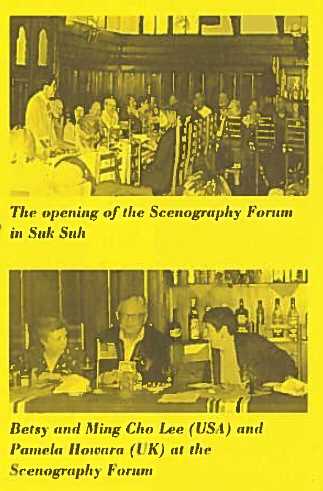
Panel Discussion with Ming Cho Lee, Ralph Koltai, and Josef Svoboda, led by Pamela Howard
A special event was a panel discussion featuring three ‘elders’ of scenography. It was probably the first time that scenographers – who usually stay backstage – attracted such a huge audience: the Prague State Opera was filled to the last seat, and scenographers and visitors from all over the world listened with great interest to the ideas of these three luminaries. The discussion was moderated in an expert and focused manner by Pamela Howard. Josef Svoboda’s investigation of different materials and the effects of light, the interpretative method of Ming Cho Lee, and the denial of having any special philosophy by Ralph Koltai (“I just happened to do it that way”) showed the wide range of both artistic development and advancements in craftsmanship which have taken place during the last decades. The British Council presented a retrospective of the work of Ralph Koltai in the Manes Building. This exhibition, along with that of the life work of Achim Freyer, enabled the last PQ of this century to offer a panoramic overview of the work of the most important senior scenographers who, by virtue of their progressive vision, nevertheless remain the youngest.
Scenographers Forum
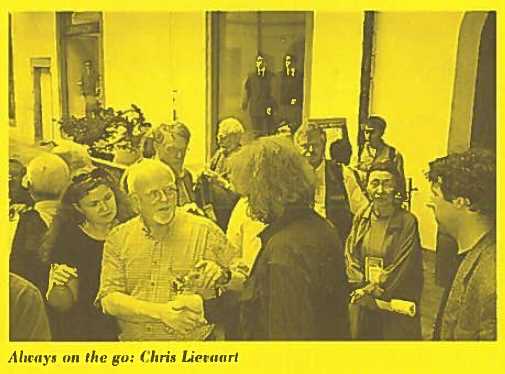 In Suk Suh, chairman of the Scenography Commission, initiated a get-together of scenographers and PQ visitors: an informal gathering gave them an opportunity to exchange views on the PQ and scenography. The meeting took place in a restaurant near the PQ, where Chris Lievaart had been kind enough to reserve a room and plan the menu. Statements made by Ralph Koltai, Ming Cho Lee, Florian Kradolfer, and others got the discussion off to a good start. In smaller circles at the large dinner table, people talked about the role of scenographers and their work, now and in the future, and exchanged addresses for further collaboration. It was also a unique opportunity for non-members of OISTAT to get an idea of the work of the organization.
In Suk Suh, chairman of the Scenography Commission, initiated a get-together of scenographers and PQ visitors: an informal gathering gave them an opportunity to exchange views on the PQ and scenography. The meeting took place in a restaurant near the PQ, where Chris Lievaart had been kind enough to reserve a room and plan the menu. Statements made by Ralph Koltai, Ming Cho Lee, Florian Kradolfer, and others got the discussion off to a good start. In smaller circles at the large dinner table, people talked about the role of scenographers and their work, now and in the future, and exchanged addresses for further collaboration. It was also a unique opportunity for non-members of OISTAT to get an idea of the work of the organization.
National OISTAT Presidents at the PQ
The Executive Committee took the initiative in inviting the presidents of the national OISTAT centres to the PQ. The importance of international exchange is not always obvious to members of the national organizations, because it does not often produce immediate results. At the PQ the presidents were able to see how international exchange functions. In addition to their visit to the exhibition and participation in the workshops and informal meetings of scenographers, they were invited by OISTAT to attend an official meeting to discuss the future of the General Secretariat in particular. The continuation of its base in the Netherlands is not certain after the year 2000, and everyone present was asked to think of alternative possibilities. This topic will be discussed again at the meeting of OISTAT’s Executive Committee in Tallin.
Meeting of the Executive Committee during the PQ
The Executive Committee of OISTAT and the commission chairs gathered for an official meeting at the theatre institute. The PQ had already opened, and, after some difficulties during the preliminary stages, the EC could report positively on OISTAT’s activities. Everyone agreed that the PQ was an excellent forum in which to bring together all the divisions of OISTAT. Besides the OISTAT Congress, active participation at the PQ will be intensified to become an essential part of the work of OISTAT. Other topics discussed included membership fees and the future of the General Secretariat. The national centres will be informed of the developments and decisions of the Executive Committee and, as far as possible, included in terms.
Bedankt, binnen enkele minuten ontvangt je een e-mail van ons met daarin een persoonlijke link. Klik op de link om een nieuw wachtwoord op te geven.